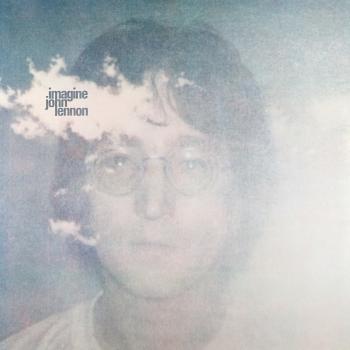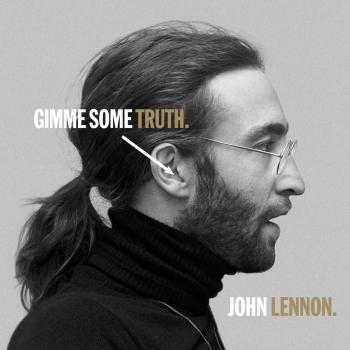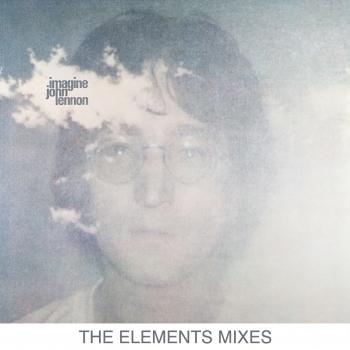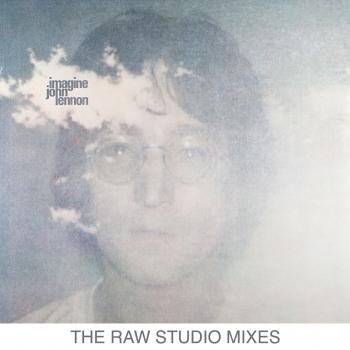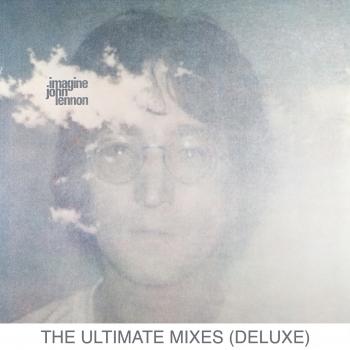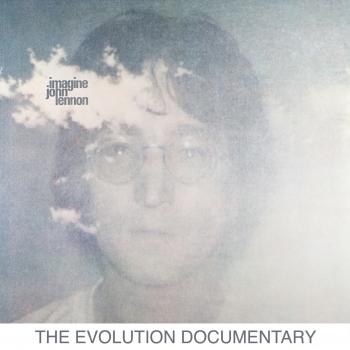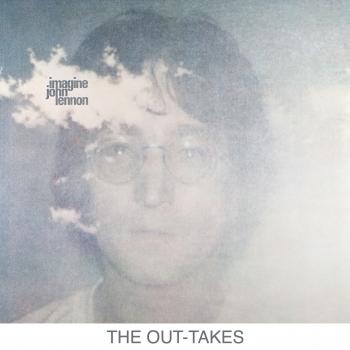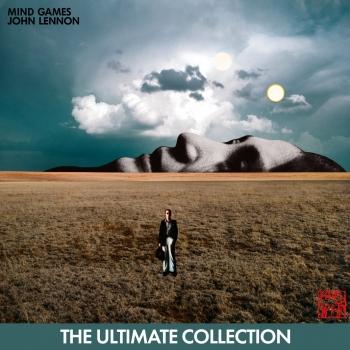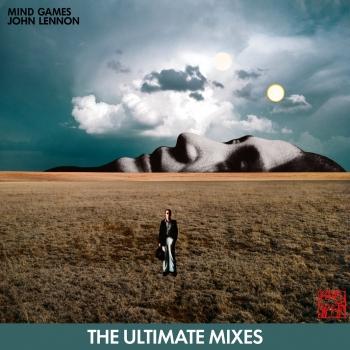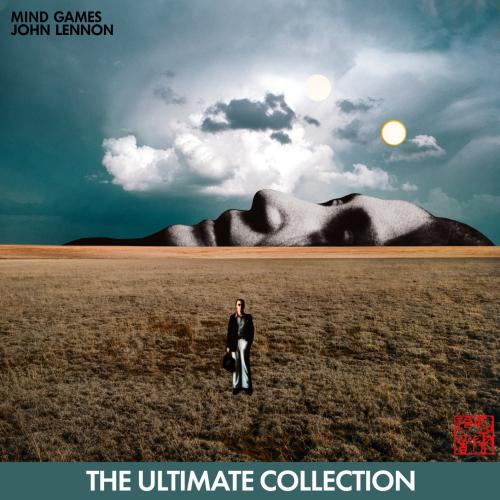
Mind Games (The Ultimate Collection) John Lennon
Album info
Album-Release:
2023
HRA-Release:
12.07.2024
Album including Album cover
I`m sorry!
Dear HIGHRESAUDIO Visitor,
due to territorial constraints and also different releases dates in each country you currently can`t purchase this album. We are updating our release dates twice a week. So, please feel free to check from time-to-time, if the album is available for your country.
We suggest, that you bookmark the album and use our Short List function.
Thank you for your understanding and patience.
Yours sincerely, HIGHRESAUDIO
- 1 Mind Games (Ultimate Mix) 04:13
- 2 Tight A Dollar (Ultimate Mix) 03:39
- 3 Aisumasen (I'm Sorry) (Ultimate Mix) 04:40
- 4 One Day (At A Time) (Ultimate Mix) 03:10
- 5 Bring On The Lucie (Freda Peeple) (Ultimate Mix) 04:12
- 6 Nutopian International Anthem (Ultimate Mix) 00:04
- 7 Intuition (Ultimate Mix) 03:11
- 8 Out The Blue (Ultimate Mix) 03:23
- 9 Only People (Ultimate Mix) 03:40
- 10 I Know (I Know) (Ultimate Mix) 03:51
- 11 You Are Here (Ultimate Mix) 04:13
- 12 Meat City (Ultimate Mix) 02:52
- 13 Mind Games (Elemental Mix) 04:11
- 14 Tight A Dollar (Elemental Mix) 03:39
- 15 Aisumasen (I'm Sorry) (Elemental Mix) 04:41
- 16 One Day (At A Time) (Elemental Mix) 03:10
- 17 Bring On The Lucie (Freda Peeple) (Elemental Mix) 04:13
- 18 Nutopian International Anthem (Elemental Mix) 00:04
- 19 Intuition (Elemental Mix) 03:11
- 20 Out The Blue (Elemental Mix) 04:15
- 21 Only People (Elemental Mix) 03:43
- 22 I Know (I Know) (Elemental Mix) 03:51
- 23 You Are Here (Elemental Mix) 04:08
- 24 Meat City (Elemental Mix) 02:52
- 25 Mind Games (Elements Mix) 03:57
- 26 Tight A Dollar (Elements Mix) 03:54
- 27 Aisumasen (I'm Sorry) (Elements Mix) 03:40
- 28 One Day (At A Time) (Elements Mix) 03:05
- 29 Bring On The Lucie (Freda Peeple) (Elements Mix) 03:17
- 30 Nutopian International Anthem (Elements Mix) 00:04
- 31 Intuition (Elements Mix) 03:09
- 32 Out The Blue (Elements Mix) 03:32
- 33 Only People (Elements Mix) 03:38
- 34 I Know (I Know) (Elements Mix) 03:49
- 35 You Are Here (Elements Mix) 04:34
- 36 Meat City (Elements Mix) 02:44
- 37 Mind Games (Evolution Documentary) 06:00
- 38 Tight A Dollar (Evolution Documentary) 05:50
- 39 Aisumasen (I'm Sorry) (Evolution Documentary) 07:45
- 40 One Day (At A Time) (Evolution Documentary) 06:24
- 41 Bring On The Lucie (Freda Peeple) (Evolution Documentary) 06:51
- 42 Nutopian International Anthem (Evolution Documentary) 00:04
- 43 Intuition (Evolution Documentary) 05:44
- 44 Out The Blue (Evolution Documentary) 07:25
- 45 Only People (Evolution Documentary) 06:28
- 46 I Know (I Know) (Evolution Documentary) 05:45
- 47 You Are Here (Evolution Documentary) 07:57
- 48 Meat City (Evolution Documentary) 07:38
- 49 Mind Games (Raw Studio Mix) 04:22
- 50 Tight A Dollar (Raw Studio Mix) 04:36
- 51 Aisumasen (I'm Sorry) (Raw Studio Mix) 04:40
- 52 One Day (At A Time) (Raw Studio Mix) 03:20
- 53 Bring On The Lucie (Freda Peeple) (Raw Studio Mix) 04:07
- 54 Nutopian International Anthem (Raw Studio Mix) 00:04
- 55 Intuition (Raw Studio Mix) 03:32
- 56 Out The Blue (Raw Studio Mix) 04:18
- 57 Only People (Raw Studio Mix) 03:44
- 58 I Know (I Know) (Raw Studio Mix) 03:55
- 59 You Are Here (Raw Studio Mix) 06:00
- 60 Meat City (Raw Studio Mix) 02:53
- 61 Mind Games (Out-take, Take 7) 04:23
- 62 Tight A Dollar (Out-take, Take 6) 02:08
- 63 Aisumasen (I'm Sorry) (Out-take, Take 2) 04:40
- 64 One Day (At A Time) (Out-take, Take 18) 03:15
- 65 Bring On The Lucie (Freda Peeple) (Out-take, Take 15) 04:30
- 66 Declaration Of Nutopia (Out-take, Take 1) 01:47
- 67 Intuition (Out-take, Take 12) 03:31
- 68 Out The Blue (Out-take, Take 15) 03:03
- 69 Only People (Out-take, Take 12) 03:32
- 70 I Know (I Know) (Out-take, Take 22) 03:42
- 71 You Are Here (Out-take, Take 5) 10:54
- 72 Meat City (Out-take, Take 16) 06:03
Info for Mind Games (The Ultimate Collection)
Anchored by the buoyant peace-and-love anthem, “Mind Games,” John Lennon’s fourth album of the same name, was surprisingly written and recorded during an incredibly tumultuous time in the rock legend’s life. In 1973, at age 33, John found himself in personal and political upheaval. A years-long deportation battle with U.S. immigration continued to rage on while his high-profile anti-Nixon campaigning, anti-Vietnam war activism, as well as the overtly political messages on his polarizing 1972 album, Sometime in New York City, made him a target of a newly elected Richard Nixon, leading to surveillance by the FBI.
This was the dramatic backdrop as John entered NYC’s Record Plant in August ’73 with a select band of world-class session musicians (jokingly named The Plastic U.F.Ono Band), including their friend drummer Jim Keltner who along with guitarist David Spinozza assembled pianist Ken Ascher, bassist Gordon Edwards, pedal-steel player “Sneaky” Pete Kleinow, saxophonist Michael Brecker, drummer Rick Marotta, backing vocalists Jocelyn Brown, Christine Wiltshire, Angel Coakely and Kathy Mull, and, to make his fourth post-Beatles solo album in just three years. John would channel this period of extraordinary activity to make a deeply personal and engrossing album of self-reflection that explored themes of love, heartbreak, peace, spirituality and social injustice, giving us yet another window into his life and soul, and some of his best solo songs, on Mind Games.
On July 12, The John Lennon Estate and Capitol/UMe will celebrate John Lennon’s pivotal and intensely personal 1973 album, Mind Games, with a suite of completely newly remixed and expanded Ultimate Collection editions, offering an immersive, deep listening experience and in-depth exploration of this classic, yet underappreciated record.
Fully authorized by Yoko Ono Lennon and produced by Sean Ono Lennon, who oversaw the production and creative direction, the Ultimate Collection is from the same audio team that worked on the critically acclaimed Imagine and John Lennon/Plastic Ono Band Ultimate Collections, including triple GRAMMY®-Award winning engineer Paul Hicks, and mixers/engineers Sam Gannon and Rob Stevens. The definitive Ultimate Collection puts listeners in the center of the studio and explores the album’s 1973 recording sessions at the Record Plant in New York City, from inception to the final master, through scores of unreleased outtakes, unadulterated versions, instrumentals, stripped down mixes, studio chatter and more, revealing how these fan favorite songs evolved and came to life.
Yoko Ono Lennon says: “John was trying to convey the message that we all play mind games. But if we can play mind games, why not make a positive future with it – to be a positive mind game? ‘Mind Games’ is such an incredibly strong song. At the time, people didn't quite get the message because this was before its time. Now, people would understand it. I don't think in those days people knew they were playing mind games anyway.”
Mind Games – The Ultimate Collection offers six different unique listening experiences that are at once immersive and intimate, ranging from the brand new Ultimate Mixes of the timeless album, which put John’s vocals front and center and sonically upgrade the sound, to the Elements Mixes, which isolate and bring forth certain instruments from the multitrack recordings to highlight playing previously buried in the original mix, and the Raw Studio Mixes, which allows listeners to hear the recording that John and The Plastic U.F.Ono Band laid to tape, mixed raw and live without vocals effects, tape delays or reverbs.
The Evolutionary Documentary is a unique track-by-track audio montage that details the evolution of each song from demo to master recording via demos, rehearsals, out-takes, multitrack exploration, and studio conversations. The Out-Takes allow listeners to hear compelling different takes of each song while the Elemental Mixes, a new set created especially for the Mind Games – Ultimate Collection, inhabit a world between the minimalism of the Elements Mixes and the Ultimate Mixes, stripping the songs back to simpler, lean-back arrangements with John’s voice to the fore, and without drums.
All of the tracks have been completely remixed from scratch from the 15 original two-inch multitrack session tapes using brand new 192-24 digital transfers.
Mind Games released on October 29, 1973 in the U.S. and November 16 in the U.K., John Lennon’s fourth solo album, Mind Games, was recorded at the Record Plant in New York with the same musicians that played on Yoko Ono’s Feeling The Space record. With her songs having become more sophisticated, Yoko enlisted a group of experienced session musicians to help realize them, in place of the looser, jammier band Elephant Memory that played on John and Yoko’s Sometime In New York City the year prior. As a result of dipping into Yoko’s sessions with this amazing band of musicians, John became inspired to record a more commercial album with the same team. Humorously named the Plastic U.F.Ono Band, the group was a who’s who of New York’s elite session musicians, including guitarist David Spinozza, bassist Gordon Edwards, drummers Jim Keltner and Rick Marotta, pianist Ken Ascher, pedal-steel player “Sneaky” Pete Kleinow, saxophonist Michael Brecker, and was rounded out with beautiful, soulful backing vocals by Something Different, featuring Angel Coakley, Christine Wiltshire, Jocelyn Brown, and Kathy Mull.
Writing for Mind Games was nearly as quick as its recording with John writing and working out a handful of new songs the week of July 16, 1973, just two weeks before going into the studio. Recording commenced August 1 and wrapped August 5 with overdubs taking place August 6-16, mixing August 21-September 18 and master tape assembly September 19-21. The album was self-produced by John, with production help from Yoko, and marked his first solo effort without Phil Spector at the helm. It was engineered by Roy Cicala and Dan Barbiero, with some studio assistance by a young Jimmy Iovine who started at the studio as an assistant towards the end of the sessions.
Despite most of the songs being written just before they were recorded, the title track, “Mind Games,” dates back to 1970 when it had the working title of “Make Love, Not War.” John was inspired to complete the soaring pop song after reading the 1972 book “Mind Games: The Guide to Inner Space,” written by Robert Masters and Jean Houston, which stressed the tapping of our mental potential to effect global change. In the tradition of Yoko’s “Imagine” poems, it was suggesting, “mind games” as a positive and creative idea.
Many of the tracks on Mind Games feature John chronicling his own life and the rocky relationship he was experiencing with Yoko at the time. The melancholic waltz “Aisumasen (I’m Sorry)” (“Aisumimasen” is Japanese for “I’m sorry”), is John at his most vulnerable, reflecting on his relationship and the remorse for the emotional pain he’s inflicted. Standout “Out The Blue” sees John expressing his doubts over the couple’s separation as the song begins with just John and a gently strummed acoustic guitar, resembling his work with The Beatles, before the band and backing singers kick in and the song builds to a soaring climax with John singing: “Like a U.F.O., you came to me/And blew away life's misery/Out the blue life's energy/Out the blue you came to me.”
The lilting “One Day (At A Time),” sung by John in a rare falsetto and featuring a classic sax solo from Michael Brecker on one of his earliest sessions, is a song about enjoying the here and now and reminding that “one day at a time is all we do,” while “Tight A$” is an innuendo-laden, rollicking country rocker with the band firing on all cylinders, including some brilliant pedal steel playing by “Sneaky” Pete Kleinow. John’s politics are showcased on tracks “Bring On The Lucie (Freda People)” and “Only People,” but in a much lighter and wittier way.
At the center of Mind Games lies the “Nutopian National Anthem,” a brief, silent three-second repose. Nutopia is the imaginary country created by John and Yoko in 1973 during their immigration woes – a conceptual nation that exists only in one’s mind, without borders, founded on love and open to everyone.
Upon its original release Mind Games sold reasonably well, peaking in the U.S. at No. 9 on Billboard and No. 13 in the U.K. The track “Mind Games”, the only single released from the record, hit No. 18 on the Billboard Hot 100 and No. 26 in the UK. Although the album received mixed reviews in 1973, over the last 50 years it has become something of a cult classic among fans and positively reassessed by critics. Renowned music writer Anthony DeCurtis gave four-stars in Rolling Stone to the 2002 reissue while NME ranked it as John’s third best solo album, writing “there’s a Beatledelic vivacity to ‘I Know (I Know)’ and the glam-friendly ‘Only People’ that Lennon would rarely capture on record again.” Most recently, Rolling Stone chose “Mind Games” as #5 on their exhaustive list of “The 100 Best Beatles Solo Songs,” declaring, “John brings all his cosmic benevolence to ‘Mind Games’, his peace-and-love anthem. ‘Mind Games’ is John at his most unfiltered: his boyish excitement, his slide guitar, his madcap humor, his spiritual yearning, his walrus-adjacent poetry, adding, “If you ever doubt John’s genius as a singer, hear the way he stretches the word ‘mind’ out to ten syllables without letting it slip. He pushes it all way too far on ‘Mind Games.’ But that’s what makes him John Lennon.”
John Lennon, lead, harmony and backing vocals, rhythm guitar, slide guitar, acoustic guitar, clavinet, percussion
Ken Ascher, piano, Hammond organ, Mellotron
David Spinozza, lead guitar
Gordon Edwards, bass
Jim Keltner, drums
Rick Marotta, drums on "Bring on the Lucie" and "Meat City" (with Keltner)
Michael Brecker, saxophone
Sneaky Pete Kleinow, pedal steel guitar
Something Different, backing vocals
Produced by Sean Ono Lennon. Mixed and Engineered by Triple GRAMMY-Award winner Paul Hicks
Mixed and Engineered by Sam Gannon and Mixed by Rob Stevens
Stereo Mastered by Alex Wharton at Abbey Road Studios
Digitally remastered
Please Note: we do not offer the 192 kHz version of this album, because there is no audible difference to the 96 kHz version!
John Lennon
If John Lennon had only been one of the four members of the Beatles, his artistic immortality would already have been assured. The so-called “smart Beatle,” he brought a penetrating intelligence and a stinging wit both to the band’s music and its self-presentation. But in such songs as “Strawberry Fields Forever,” “Norwegian Wood (This Bird Has Flown),” “Rain” and “In My Life,” he also marshaled gorgeous melodies to evoke a sophisticated, dreamlike world-weariness well beyond his years. Such work suggested not merely a profound musical and literary sensibility – a genius, in short — but a vision of life that was simultaneously reflective, utopian and poignantly realistic.
While in the Beatles, Lennon displayed an outspokenness that immersed the band in controversy and helped redefine the rules of acceptable behavior for rock stars. He famously remarked in 1965 that the Beatles were “more popular than Jesus” – a statement that was more an observation than a boast, but that resulted in the band’s records being burned and removed from radio station playlists in the U.S. He criticized America’s involvement in Vietnam, and, as the Sixties progressed, he became an increasingly important symbol of the burgeoning counterculture.
But it was only after the breakup of the Beatles in 1970 that the figure the world now recognizes as “John Lennon” truly came into being. Whether he was engaging in social activism; giving long, passionate interviews that, once again, broadened the nature of public discourse for artists; defining a new life as a self-described “househusband;” or writing and recording songs, Lennon came to view his life as a work of art in which every act shimmered with potential meaning for the world at large. It was a Messianic attitude, to be sure, but one that was tempered by an innate inclusiveness and generosity. If he saw himself as larger than life, he also yearned for a world in which his ego managed at once to absorb everyone else and dissolve all differences among people, leaving a Zen-like tranquility and calm. “You may say I’m a dreamer, but I’m not the only one,” he sang in “Imagine,” which has become his best-known song and an international anthem of peace. “I hope someday you’ll join us, and the world will live as one.”
Such imagery, coupled with the tragedy of his murder in 1980, has often led to Lennon’s being sentimentalized as a gentle prince of peace gazing off into the distance at an Eden only he could see. In fact, he was a far more complex and difficult person, which, in part, accounts for the world’s endless fascination with him. Plastic Ono Band (1970), the first solo album he made after leaving the Beatles, alternates songs that are so emotionally raw that to this day they are difficult to listen to with songs of extraordinary beauty and simplicity. Gripped by his immersion in primal-scream therapy, which encouraged its practitioners to re-experience their most profound psychic injuries, Lennon sought in such songs as “Mother” and “God” to confront and strip away the traumas that had afflicted his life since childhood.
And those traumas were considerable. Lennon’s mother, Julia, drifted in and out of his life during his childhood in Liverpool – he was raised by Julia’s sister Mimi and Mimi’s husband, George – and then died in a car accident when Lennon was seventeen. His father was similarly absent, essentially walking out on the family when John was an infant. He disappeared for good when Lennon was five, only to return after his son had become famous as a member of the Beatles. Consequently, Lennon struggled with fears of abandonment his entire life. When he repeatedly cries, “Mama, don’t go/Daddy come home,” in “Mother,” it’s less a performance than a scarifying brand of therapeutic performance art. And in that regard, as well as many others, it revealed the influence of Yoko Ono, whom Lennon had married in 1969, leaving his first wife, Cynthia, and their son Julian in order to do so.
The minimalist sound of Plastic Ono Band was significant too. Lennon had come to associate the elaborate musical arrangements of much of the Beatles’ later work with Paul McCartney and George Martin, and he consciously set out to purge those elements from his own work. Co-producing with Ono and the legendary Phil Spector, he built a sonic environment that could not have been more basic – guitar, bass, drums, the occasional piano — whatever was essential and absolutely nothing more. Lyrically, he turned away from the psychedelic flights and Joycean wordplay of such songs as “I Am the Walrus” and “Lucy in the Sky With Diamonds” – as well as his books, In His Own Write and A Spaniard in the Works — and toward a style in which unadorned, elemental speech gathered poetic force through its very directness.
On his next album, Imagine (1971), Lennon felt confident enough to reintroduce some melodic elements reminiscent of the Beatles into his songs. Working again with Ono and Spector, he retains the eloquent plainspokenness of Plastic Ono Band, but allows textural elements such as strings, to create more of a sense of beauty. The album’s title track alone ensured its historical importance; it is a call to idealism that has provided solace and inspiration at every moment of social and humanitarian crisis since it was written.
From there Lennon turned to a style that was a sort of journalistic agit-prop. Sometime In New York City (1972) is as outward-looking and blunt as Imagine was, for the most part, soft-focused and otherworldly. As its title suggests, the album reflects Lennon’s immersion in the drama and noise of the city to which he had moved with Yoko Ono. And as its cover art suggests, the album is something like a newspaper – a report from the radical frontlines on the political upheavals of the day. His activism would create enormous problems for Lennon, however. The Nixon administration, paranoid about the possibility that a former Beatle might become a potent leader and recruiting tool of the anti-war movement, attempted to have Lennon deported. Years of legal battles ensued before Lennon finally was awarded his green card in 1976.
Lennon’s political struggles unfortunately found their match in his personal life. He and Ono split up in the fall of 1973, shortly before the release of his album, Mind Games. He moved to Los Angeles and later described the eighteen months he spent separated from Ono as his “lost weekend,” a period of wild indulgence and artistic drift. Like Mind Games, the albums he made during this period, Walls and Bridges (1974) and Rock N Roll (1975), are the expressions of a major artist seeking, with mixed results, to recover his voice. None of them lack charm, and their high points include the lovely title track of Mind Games; Walls and Bridges’ “Whatever Gets You Through the Night,” a rollicking duet with Elton John that gave Lennon his first number-one single as a solo artist; and the sweet nostalgia of Rock N Roll, a covers album that was Lennon’s tribute to the musical pioneers of his youth. But none of those albums rank among his greatest work.
In 1975, Lennon reunited with Ono, and their son Sean was born later that year. For the next five years, Lennon withdrew from public life, and his family became his focus. Then, in 1980, he and Ono returned to the studio to work on Double Fantasy, a hymn to their life together with Sean. The couple was plotting a full-fledged comeback – doing major interviews to support the album’s release, recording new songs for a follow-up, planning a tour. Then, shockingly, Lennon was shot to death outside the apartment building where he and Ono lived on the night of December 8, 1980. (Anthony DeCurtis). Source: www.johnlennon.com
This album contains no booklet.











